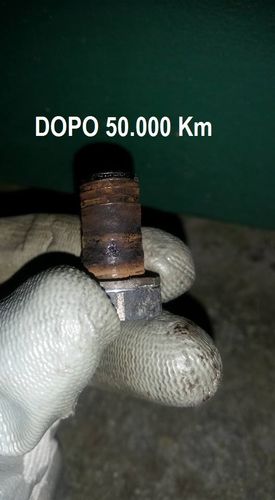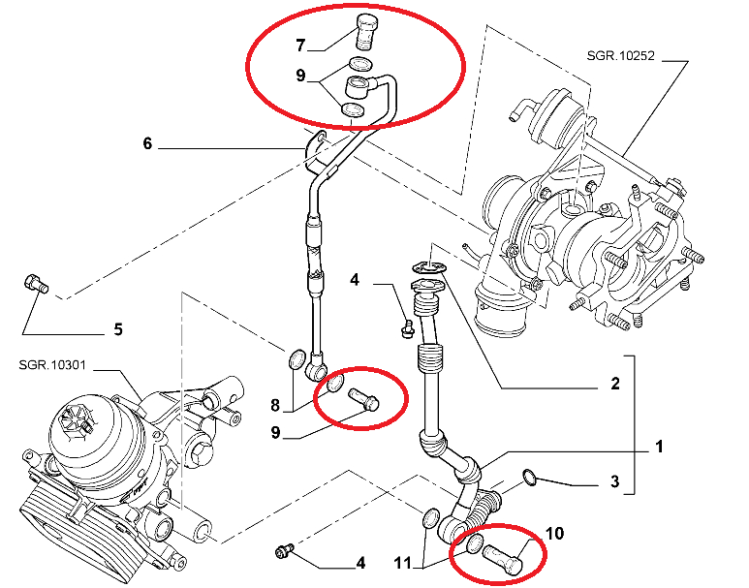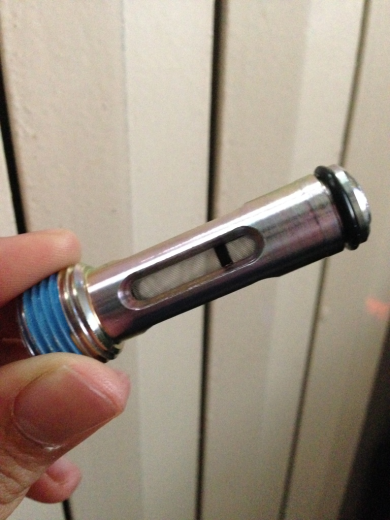Go directly to: Multiair Brick Oil Filter

photo courtesy of Peter T.
There is an oil supply tube exiting the oil cooler/filter housing, the other end of which you’ll find attached to the top of your turbo (shown in the photo above inside the green circle) that feeds cooled/filtered oil to lubricate the bearings as it spools up to 230,000 RPM. Unbeknownst to most of us, and not mentioned in the Owner’s Manual that I am aware of, the turbo itself has it’s own oil filter, located within the hollow “banjo” bolt (also identified in the photo above), that has a history of disintegrating at some point. I imagine this is an industry-wide practice to protect the turbos from engine break-in metal fragments that have snuck past the engine’s primary oil filter. Also, remember that the oil filter bypass valve will remain open, once the cartridge has become clogged (contaminated oil, not changing the oil filter when scheduled, etc.).
Should turbo oil flow become inhibited by a clogged filter element within the bolt, you would be looking at a very expensive repair to replace the turbo assembly. Peter T. has learned about this issue through an Italian Alfa Romeo forum, and was kind enough to bring to my attention, that this filter bolt (also known as a banjo bolt by Mopar – thanks Mike34!; use a 17 mm socket – thanks goaterguy!) should probably be inspected during every other oil change (approximately every 15,000 miles), and replaced if the filter doesn’t appear to be in working condition. It appears that oil filter elements aren’t sold alone, but instead, a new filter bolt (#7 in diagram below), along with two new gaskets or crush washers (#9 in diagram below), must be purchased as a replacement.

don’t let your filter bolt get this bad!!

⬅️ In fact if I read the diagram correctly, there are a couple more banjo bolts on the other end of the hoses (#9 and #10 at the engine oil filter), but I do not believe they contain filter elements.
[UPDATE 2/26/2022]
According to Spideromeo and others, the discussed banjo bolt in some (or perhaps all) of our 124 Spiders don’t seem to include a filter element, so until further notice, most of us can just leave this alone (saves finding new crush washers).
Multiair-brick oil filter bolt
Peter T. has also pointed out, that the multiair brick is also protected by a filter “banjo” bolt, with an unspecified change interval, as shown in his two photos below. I would venture to say, that since it can’t be accessed until the timing belt cover has been removed, if not replacing the filter bolt, consider at least inspecting the condition of the internal element, while replacing the timing belt and water pump. The condition of the turbo filter bolt should also serve as a good indicator as to the condition of the brick’s oil filter, and whether it might be a good idea to replace sooner than the 100,000 to 150,000 miles recommended for replacing the timing belt, so as not to “brick” the brick 😉
He has provided European (Ricambi) part numbers for the various known filter bolts:
MULTIAIR FILTER #: 55238665 ◊ TURBO FILTER #: 71769773 ◊ OIL FILTER #: 73500049
(The Mopar (U.S.) part # for the Multiair filter bolt is 68189847AA)
Driving Impressions in New Jersey, is an alternative source for the OEM multiair filter banjo bolt: https://www.teamdi.com/product/fiat-multiair-engine-multiscreen-filter/ . Based on their experience with the 1.4 L engine, they recommend changing at 60,000 mile intervals.


excerpt courtesy of mitoregister.com regarding the same filter in the alfa romeo multi-air engine
Alternatively, aftermarket bolts have been developed (minus the filter element), that insure good continuous (unrestricted*) oil flow, which I’m sure are to be used with an unwritten assumption that good quality engine oil filter cartridges will be installed when oil changes are called for (so that the oil filter bypass valve is never engaged). Peter was able to locate a quality alternative product, and had his mechanic replace his filter bolt with it, so that he needn’t concern himself with this potential blockage source any longer.
These have 4 holes (instead of 2 like the OEM bolts), and inside it has NO filter .. so it can never tarnish or clog, and will always guarantee an excellent lubrication to the turbine bearings.

I’m hoping that I will be able to locate other sources for these bolts, besides a workshop in Italy.
* Iain points out in a comment below, that perhaps the restriction offered in the factory filter bolts is intentional. I can’t render an opinion on that subject, but hopefully an expert will chime in.
![]() Or, if they are not easily obtainable (and don’t look like the clogged filter bolt in the second photo), you could simply rid the OEM bolt of the suspect filter element by cleaning it out with compressed air, and then reinstall the bolt using new crush washers, with 14.75 ft.•lb. (20 N•m) of torque.
Or, if they are not easily obtainable (and don’t look like the clogged filter bolt in the second photo), you could simply rid the OEM bolt of the suspect filter element by cleaning it out with compressed air, and then reinstall the bolt using new crush washers, with 14.75 ft.•lb. (20 N•m) of torque.

Never ceases to amaze me all the stuff you dig up. If I get the specs I could probably make these bolts in the workshop.
LikeLiked by 1 person
I think they are 12 x 1.5, with a 19 mm head, but that should all be verified 😉
Also, Peter has just observed that the underside of the bolt head would also need to be machined as a sealing surface.
LikeLike
Wow! I had no idea/ I did find this…a part number for the hose. It shows the banjo bolt [#7] in diagrams but doesn’t list it as a separate part number. Mopar Part No.: 4892965AB TUBE-OIL FEED
LikeLiked by 1 person
Mike, bolts #9 and #10 in the diagram I just added aren’t banjo bolts too, are they? If so, I would hope that they don’t also have filter elements…
LikeLiked by 1 person
Appears #9 and #10 in the above exploded diagram are banjo bolts. I doubt they are oil filter types though. I’m sure some one that has replaced/removed the turbo could confirm. Replacing that every 15000 miles!!! I’m past due!!
LikeLike
Should be inspected every 15,000 miles, not replaced 😉 That bad one in the photo is dopo (italian for over) 31,000 miles though. I’ll bet that wasn’t a well cared-for Spider either, probably some work vehicle that never got it’s oil changed.
LikeLike
looks like the GT1446 should have a 1.8mm restrictor in the top banjo when installed on a t-jet or muitiair engine.
LikeLike
Iain brings up a valid point, and I’ve added a note in the article
to encourage further discussion.
LikeLike
Ooohh! and this is the gasket/s for the banjo. Mopar Part No.: 68166578AA GASKET-BANJO
LikeLiked by 2 people
Gasket as in washer?
LikeLike
I’m under the impression that Garrett uses gaskets, but the referenced aftermarket filter bolt supplier has chosen to use crush washers instead. Either will work.
LikeLike
From what I have read owners might also want to occasionally inspect / replace the oil filter of the Multiair unit.
If the instructions on transverse mounted engines also apply it should be a straightforward job. Just remove the timing belt cover and unbolt the filter.
LikeLiked by 1 person
My turbo was replaced under warranty about a month ago. I bought two gaskets and removed the banjo and the filter was already removed. The bolt is a 17mm.
LikeLiked by 1 person
Thanks for the comment. Your statement on the missing filter is interesting, in that it’s purpose is
so is Mopar assuming that replacement turbos are always purchased for engines that have already been broken-in? (Probably a reasonable assumption.)
I incorporated your bolt head size into the article, but out of curiosity, what prompted you to inspect that filter on a brand new turbo?
LikeLike
I reused the crush washers while inspecting. Is that a problem sir?
LikeLike
Hi, after the reading of this article, I have decided to buy the alternate replacement to the OEM filter as described above. The source is Italian and it was easy to get one for 20 euro incl shipping . Now, looking at the original bolt on my turbo which I ll remove later this week end, I have noticed a vertical mark painted “by hand” on the head of the bolt down to the lubricating pipeline that looks like a reference , sort of alignment.
On the other hand if I look at the replacement bolt that I have in my hands, I wonder weather there must be an alignment with the pipeline: 4 holes, two must be aligned to the lubricating pipeline, correct? I wonder how to reach correct torque and align the holes properly at the same time.
Dumb /rookie question, I know.
LikeLike
Claudio,
Not a dumb question at all. I hope someone that is quite familiar eventually replies, but here is my engineering guess…
LikeLike
thanx for your super quick reply Ameridan . I picked up the phone and asked the manufacturer who sold me the unfiltered bolt more info on the subject. He confirmed me exactly -word by word- what your “engineering guess” were: spot on! The mark, was indeed made for torque affirmation.
Super Ameridan, thanx
LikeLiked by 1 person
The only worry id have removing the restriction is that its probably there for a reason. modern Garrett turbos generally require a restrictor due to engine oil pressure being more than the turbo requires. without it, there can be a build up inside the turbo centre and it will push through the seals. if it was me, id keep an eye on it and replace with a factory item if required.
LikeLiked by 1 person
Iain, I’ve incorporated your comment into the article, as you bring up a valid point worthy of more discussion. I also read an article today regarding the multiair brick filter bolt, and incorporated that into the article as well.
LikeLike
Here’s another source for the filter, although it doesn’t look like the gaskets are included:
https://www.teamdi.com/product/fiat-multiair-engine-multiscreen-filter/
LikeLike
That link was already in my article 😉
LikeLike
Oops, sorry.
Please delete my duplicative post.
Thanks!
LikeLike
I stopped by the banjo bolt shop in Italy LOL. Apparently, only one bolt on top of the turbo has the filter according to the shop,
he also recommended this for the turbo application to change the hose out which I picked up as well.
https://www.mtelaborazioni.it/product/tubazione-mandata-olio-in-treccia-metallica-mtelaborazioni/
LikeLike
Thanks to Davide Tartari for sharing an article from mitoregister.com regarding the same filter in the alfa romeo multi-air engine, which i added an excerpt from.
LikeLike
Based on feedback, I added an update to my article:
According to Spideromeo and others, the discussed banjo bolt in some (or perhaps all) of our 124 Spiders don’t seem to include a filter element, so until further notice, most of us can just leave this alone (saves finding new crush washers).
LikeLike
I wish there was some kind of flag letting us know a message awaited is on 124Spider.org forum, because I just found a 2-year-old message from Bill with another source for banjo bolts. Not sure which one is used where though…
https://shop.mambatek.com/Turbo-Oil-Feed-Banjo-Bolt-FIAT-500-Abarth-Garrett-810944-GT1446-K028-0025-1.htm
LikeLike
It’s best not to re-use the crush washers, but I guess if it isn’t leaking, you’ll probably be fine (this time).
LikeLike